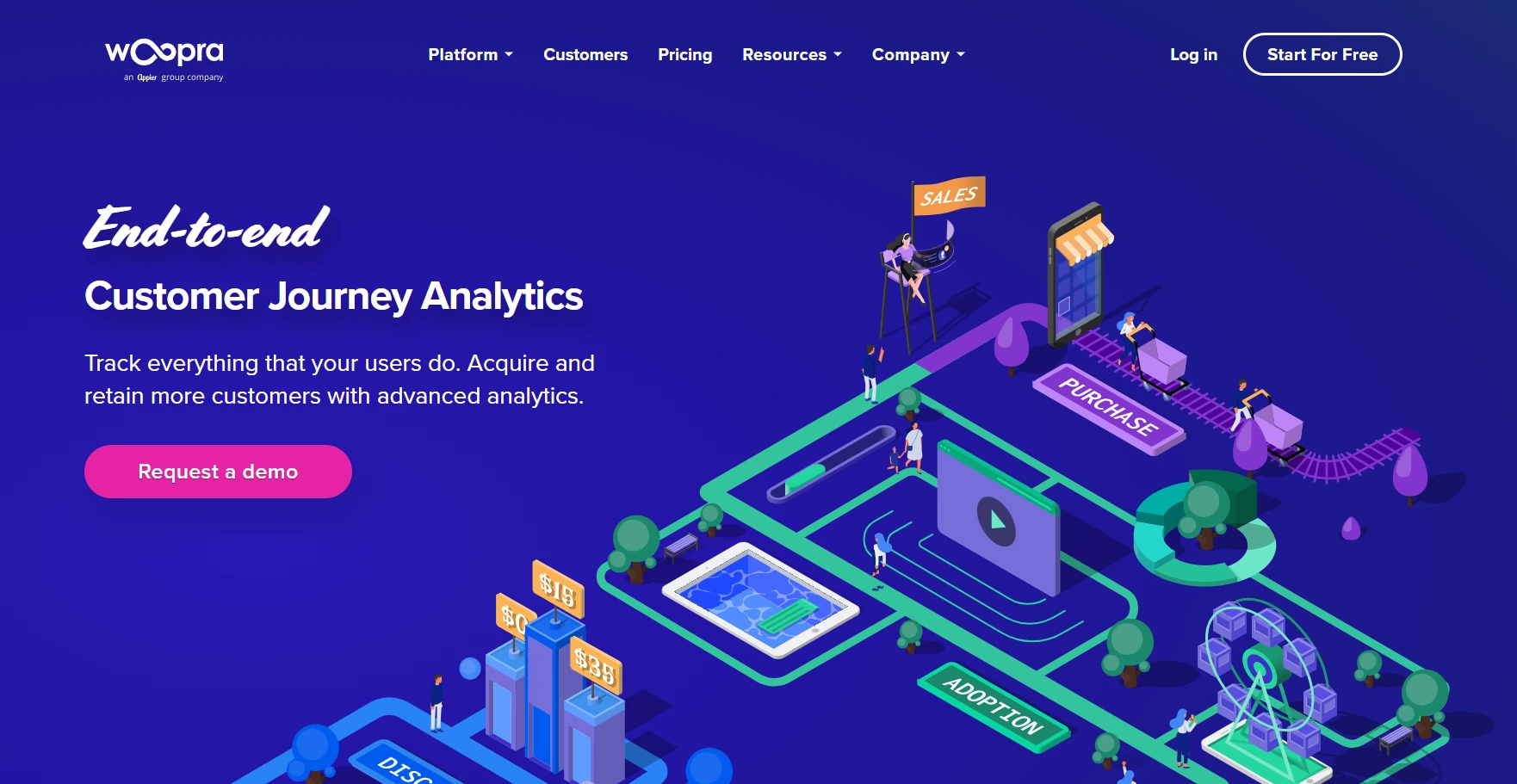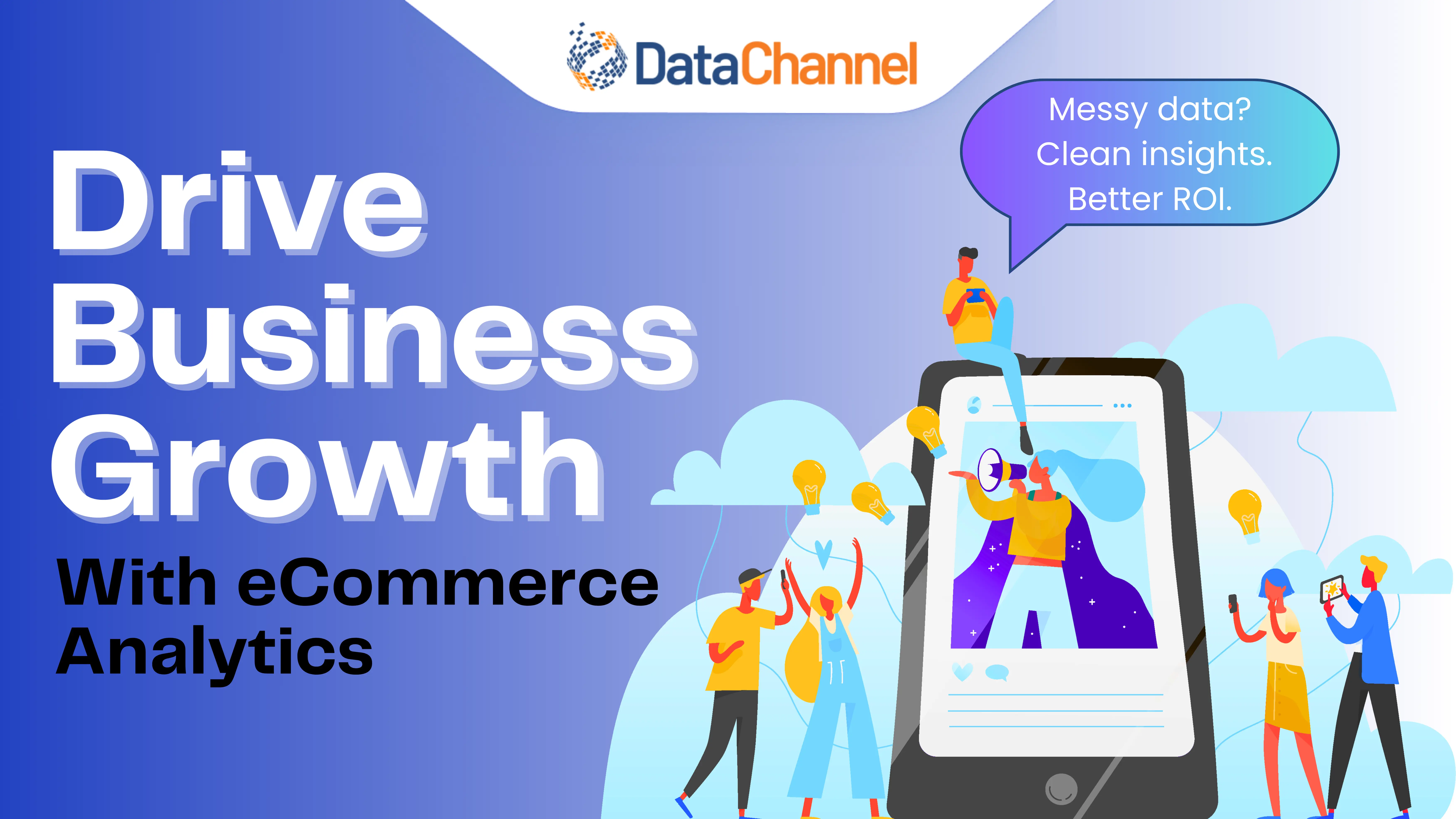
Top 7 Analytics Tools For Ecommerce

Every business, irrespective of its size and domain, is turning digital. The use of online shopping has increased significantly in recent years and in 2025 only, retail e-commerce sales are estimated to exceed 4.3 trillion U.S. dollars worldwide.
Thus, making it necessary for retailers to have the right tools to understand their customers and market.
Enter: Ecommerce analytics tools that provide insights into key performance metrics and customer behavior, helping D2C (Direct-to-Consumer) companies make data-driven decisions. These tools typically track website traffic, conversion rates, sales data, customer demographics, and more.
In order to make these data-driven decisions, it's important to ensure that data is accurate, consistent, and up-to-date for meaningful analysis and reporting. This is where a successful data integration strategy comes in that also serves businesses’ specific data needs.
In our detailed blog on Top 7 analytics tools for Ecommerce, we’ll be talking about some of the best tools that can be used to make Ecommerce analytics easy and strong for you. We have also included a few bonus entries in our list that consist of all the new and rising tools that users are increasingly adopting.
Let’s start with the basics first!
What is Ecommerce Analytics?
Ecommerce analytics is the process of collecting, interpreting, and utilizing data from online shopping activities to guide strategic business decisions. It enables businesses to monitor and optimize every aspect of the customer journey from website traffic & user behavior to conversion rates, and customer retention.
By analyzing data across multiple channels such as websites, social media, advertising platforms, and CRM systems. Ecommerce analytics helps businesses gain a 360-degree view of how their customers interact with their brand.
These insights empower marketing and analytics team to:
✅Identify which products and campaigns drive the most revenue
✅Understand drop-off points in the sales funnel
✅Segment customers based on behavior, demographics, or purchase history
✅Predict future buying behavior through predictive analytics
✅Optimize customer lifetime value (CLV) and return on ad spend (ROAS)
Ecommerce analytics gives brands the insights they need all while making sure every decision is backed by accurate, actionable data. But it is also equally important to choose the right tool for your business, one that covers all the key parameters needed to support and drive business growth.
Top Parameters to Consider Before You Choose Your Next Ecommerce Analytics Tool
There are multiple vital factors that you must look into to get the best Ecommerce analytics tool for your online business. These factors can help you determine which tool best meets your business needs and goals.
- User Acquisition and Retention: Your preferred analytics tool should be able to track and analyze the customer journey, including acquisition channels and behavior over time.
- Conversion Rate Optimization: Factors like tracking and analyzing conversion rates, identifying key bottlenecks, and measuring the impact of changes to the conversion process are some must-haves for your next Ecommerce analytics tool.
- Sales and Revenue: Top Ecommerce analytics tools monitor sales and revenue performance, understand key drivers of growth, and measure the impact of marketing initiatives.
- Customer Lifetime Value: Tools in the market today can seamlessly measure and analyze the value that customers bring over their lifetime, including repeat purchases and cross-sell/up-sell opportunities.
- User Experience: You should be able to track and measure the user experience on the website and app, including page load times, engagement, and customer feedback with a third-party e-comm analytics tool.
Key Metrics To Monitor for Successful Ecommerce Analytics
The right Ecommerce analytics tool will also give you details into the right kind of metrics to drive your business growth. Below are mentioned a few of the key metrics that make your Ecommerce analytics successful in the long run.
- Average Order Value (AOV)
Ever wondered, how much are your customers really spending per order? Well that’s what AOV reveals. Average Order Value (AOV) helps you understand the average amount customers spend every time they make a purchase in your store. Let’s say your online store brought in $36,000 in revenue this week, and that came from 180 individual orders. Your AOV would be $200 ($36,000 ÷ 180). Now imagine you launched a “Buy 2, Get 1 Free” campaign that boosted that to $225 the following week - that’s a clear win. It’s one of the most critical indicators of how well your product bundles, discounts, and upsell strategies are working.
- Customer Retention Rate (CRR)
It feels great winning a customer once. But winning them again and again, that’s how your brand scales. Customer Retention Rate (CRR) shows how well your business keeps customers coming back by building a trustworthy relationship with customers. High retention rates means your customers are satisfied, engaged, and finding consistent value - which is far more cost-effective than constantly chasing new traffic.
- Cart Abandonment Rate
This metric tracks how often shoppers add products to their cart but don’t complete their purchase. It’s a critical sign that something in the buying journey is broken. Let’s say your eCommerce site had 1,000 carts created last week. Out of those, only 300 converted into complete purchases, giving you a cart abandonment rate of 70%. Monitoring this metric helps you identify barriers and improve conversion paths.
- Return on Ad Spend (RoAS)
RoAS helps you track money you spend on ads so that you can steer clear of any major roadblocks or unwanted hiccups.
How to Measure RoAS? Say your brand launches a Meta Ads campaign and invests $5,000 into promoting a new product line. That campaign brings in $20,000 in direct revenue. Your RoAS would be $20,000 ÷ $5,000 = 4, meaning you earn $4 for every $1 spent on ads. But imagine discovering some campaigns are bringing in only $1.20. Well, without RoAS, you’d never know.
- Net Promoter Score (NPS)
Unlike other metrics that measure transactions or clicks, NPS captures sentiment -
How do your customers feel about your brand? and Whether they’d tell someone else about it?
Here’s how it works: Imagine sending out a quick one-question survey to 1,000 recent customers asking, “How likely are you to recommend our store to a friend?” on a scale of 0 to 10. Let’s say 60% of your customers are promoters (giving you a score of 9/10), 25% are neutrals (a score of 7/8), and 15% are detractors (a score of 6 or below). Now, your NPS would be 60% - 15% = 45, a strong score, but also a benchmark to beat next time. With a clear understanding around all the required parameters & metrics, we can now move ahead to discuss in detail the best Ecommerce Analytics tools that can serve your unique business needs successfully.
The Best Ecommerce Analytics Tools
According to a 2023 IBM Institute for Business Value study, 79% of retail and consumer products companies are actively implementing or experimenting with AI technologies, up from just 48% in 2019 (IBM, 2023). This dramatic increase demonstrates the industry’s recognition of AI as a critical competitive differentiator rather than merely an optional enhancement.
In today’s day and age of AI powered Analytics, finding and building the right tech stack that also offers seamless AI integration has also become businesses’ one of the core requirements. That’s why we are listing down the best Ecommerce analytics tools that are different based on their AI functionality, ease of use, and among other benefits.

Google Analytics

Every individual in the data-driven business world must be familiar with Google Analytics. It is one of the best analytics tools that you can use for free. It is easy to align an eCommerce site with Google analytics. With this platform at your end, you can easily keep a tab on the amount of traffic coming to your virtual doorstep. You can quickly figure out which marketing strategies are working best for you and which are not, so that emphasis can be put on the ones that are bringing favorable outcomes. The tool will help you keep an eye on:
- How each product is performing on your site
- From where the traffic is coming (desktop, mobile, tablet) and what is making that traffic convert.
- Which pages on your site have the most engagement and which pages are contributing to the bounce rate.
Google Analytics will inform you how many visitors are checking your site daily, which products they are interested in, how much time they spend on each page, and so much more. The tool has enhanced eCommerce capabilities that can help you retain your present customers and attract new ones.
Every individual in the data-driven business world must be familiar with Google Analytics. It is one of the best analytics tools that you can use for free. It is easy to align an Ecommerce site with Google analytics.
While it’s long been popular for tracking website traffic and engagement, the latest version: GA4, introduces advanced capabilities that go far beyond basic analytics. GA4 provides seamless cross-platform tracking and enhanced measurement for automatic tracking of key interactions. What also sets GA4 apart is its AI and machine learning capabilities, offering predictive metrics to identify user segments for proactive campaign optimization and anomaly detection.
Woopra

In an eCommerce store, few things are more frustrating than customers abandoning an order. Whether it’s due to complex navigation, pricing, or payment terms, these issues must be addressed to prevent business loss.
Woopra helps eCommerce merchants tackle this by monitoring the abandonment rate based on actions like payment or shipment, and identifies which parts of the funnel need attention.
- With real-time customer journey tracking, you can instantly see how visitors move across your site and mobile app. Event-based analytics allow for custom action tracking without major development effort.
- Woopra also integrates with Salesforce, Slack, Intercom, Hubspot, and 50+ others, ensuring seamless data sync.
- On the AI front, predictive analytics help forecast conversion, churn risks, and build Personalization triggers power tailored on-site experiences - driving engagement and increasing conversions
Experro

Experro is a top choice for those seeking comprehensive Ecommerce analytics solutions providing unmatched insights into customer interactions and behaviors along with real-time data that enables businesses to make swift adjustments to their strategies, driving smarter decisions and better outcomes.
Experro’s Top Features:
- Segment customers, analyze behaviors, and improve sales performance with never-before-seen insights.
- Detailed conversion rate and bounce rate optimization tools.
- In-depth eCommerce performance metrics across multiple channels with Experro’s CDP Suite.
- Advanced segmentation and customer behavior track reports.
Hotjar

It is difficult to assume how each customer sees your eCommerce store. To find what’s on your website that will boost the click-through rate and increase the conversion rate, you have to step into your customer’s shoes.
Hotjar is a heat mapping eCommerce analytics tool that can help you by providing a bird’s-eye view of what your visitors see on your site. It lets you create recordings of your real-time customers so that they can see how your customers are interacting and develop insights that will enhance the conversion rate significantly. Now enhanced with heatmaps and session recordings, Hotjar offers even deeper visual representations of user clicks, taps, scrolling behavior, allowing teams to pinpoint exactly where users are engaging or dropping off.
By monitoring the activities of your real-time customers, you can always get answers to the following questions:
- Why are your visitors not clicking on your CTAs?
- What’s on your website is grabbing the audience’s attention?
- What are the errors or bugs that are not letting the conversion rate to boost?
Kissmetrics

Kissmetrics is a highly advanced analytical platform that provides valuable user-centric insights, enabling brands to deliver great products at leading prices. The tool drills down to users who actually visited your product page, separating them from those who bounced after a quick site visit.
- Through customer segmentation, you can group users based on behavior or demographics, making your marketing campaign more targeted and effective - clearly highlighting which strategy is generating leads and which needs reworking.
- The platform pinpoints elements in your website design that may hinder engagement, enabling changes that increase interaction and reduce bounce rate.
- Though it comes at a cost, the tool’s predictive analysis and churn detection capabilities offer advanced value - estimating customer lifetime value and flagging early signs of disengagement so you can take action before losing a customer.
Mixpanel

Mixpanel is a web and mobile analytics platform that helps eCommerce businesses understand their customers and optimize their website performance. It provides real-time insights into user behavior, website performance, and customer engagement, allowing businesses to make informed decisions and improve customer experience.
Today, Mixpanel offers powerful new features like interactive reports, that allow users to build and customize visual dashboards using real-time data. Its cohort analysis tools enable businesses to track user groups over time, offering deeper insights into retention and engagement patterns. With built-in A/B testing, eCommerce teams can experiment with features or UI changes to find what drives conversions and engagement.
Glew

Glew.io is a powerful eCommerce analytics platform that provides businesses with valuable insights into their customer data. By integrating with multiple eCommerce platforms like Shopify, WooCommerce, and Amazon, it collects and analyzes customer data from various sources, providing a comprehensive view of customer behavior and website performance.
- The platform supports multi-store reporting and inventory & product analytics for real-time performance tracking.
- This data is crucial for improving website performance and optimizing customer experience.
- Glew.io features a Jeanie AI Assistant which is a conversational AI that analyzes unified commerce data, uncovers opportunities, and delivers AI briefs via email.

Bonus Entries (Ecommerce Analytics Tools)
Optimizely

Optimizely is a powerful website optimization platform that enables eCommerce businesses to test, personalize, and optimize their website to improve customer experience and drive conversions. It provides a range of tools that let businesses test variations of their website, analyze results, and make data-driven decisions to optimize website performance.
- With AI-powered tools like Opal AI Marketing Agents, businesses can streamline campaign creation, generate content summaries, and manage tasks efficiently inside Optimizely’ AI hub, powered by Google Gemini.
- The platform now supports Automatic Alt-Text Generation for better accessibility and SEO, and allows enterprises to Bring Your Own AI models like OpenAI, enhancing content suggestions and search optimization.
- For website optimization, enhanced capabilities, like image transformation (via GPT-4o and DALL·E 3) boost visual engagement.
- For personalization, AI-Suggested Segments recommend audience groups based on behavior, while real-time segment size estimation improves targeting.
Glassbox

Glassbox is an Ecommerce analytics tool that provides valuable insights into customer behavior and website performance. Glassbox allows Ecommerce businesses to focus on key metrics through customizable dashboards and provides granular data analysis to help businesses understand customer behavior and identify areas for improvement.
- Its cross-device analytics ensure full visibility into web, native, and hybrid app interactions in one seamless view, while UX features like funnels, session replays, mobile crash analysis, and page grouping help track key events tied to performance metrics.
- Voice-of-the-Silent expands beyond traditional feedback by inferring behaviors of users who don’t submit responses - uncovering silent friction points.
- Its AI capabilities, led by GIA (Glassbox Insights Assistant), leverage generative AI to answer conversational queries, flag user struggle points, and automate full-dataset analysis for anomaly detection and behavior forecasting.
Adobe Analytics
.webp)
Adobe Analytics has long been recognized as one of the most powerful tools for enterprises that need more than just basic web traffic reports. Now, with its latest advancements, it goes far beyond surface-level metrics - giving eCommerce businesses a deeper, real-time understanding of the entire customer journey.
- At its core is Customer Journey Analytics, which merges data from multiple online and offline sources - including websites, mobile apps, CRM systems, and call centers - into one cohesive view. This omnichannel approach reveals how customers move from interest to purchase across every touchpoint.
- The platform’s native AI engine, Adobe Sensei, uncovers hidden patterns, powers predictive modeling, and automates complex analysis. Intelligent alerts notify teams the moment data anomalies or trend shifts occur.
CrazyEgg

Crazy Egg is an intuitive website optimization tool designed to help eCommerce businesses visually understand how users interact with their site and identify exactly what’s working - and what isn’t.
- Crazy Egg enables active experimentation with its A/B testing functionality - making it easy to test variations of headlines, CTAs and layouts to optimize conversion rates. Complementing this, the user feedback and error tracking features let you deploy on-page surveys, monitor form abandonment, and catch broken links to improve UX in real time.
- On the AI front, automated anomaly detection flags unexpected shifts in user behavior or performance issues, ensuring fast responses to emerging problems.
- AI-informed optimization suggestions synthesize test results and visual data to recommend impactful UX improvements.
DataChannel Helps You Make Sense of Your Ecommerce Data
Just adding an eCommerce analytics tool doesn’t suffice in many cases. To effectively analyze eCommerce data, the data needs to be cleaned, transformed, and structured in a way that can be easily understood by the analytics tool or business intelligence platforms. However, setting up ETL workflows and pipelines is not a simple task due to inherent challenges of handling multiple data sources, each with their own APIs, authentication systems, data formats, and rate limitations, along with continually changing business requirements. This leads to extensive manual effort and time consumption, with data teams often stuck in data monitoring, pipeline maintenance, and struggling to scale real-time analytics.
The alternative? Adapting a fully-managed ETL platform that supports data pipeline automation, scalability, and seamless data warehouse integration.
Tools like DataChannel ensure that your data is properly formatted and structured so your eCommerce analytics tool can deliver meaningful insights and actionable analysis.
For example, DataChannel enables reporting on key metrics like most popular products, average order value, customer purchase history, and the geographical distribution of sales. These insights fuel customer segmentation, dynamic pricing strategies, campaign optimization, and personalized experiences. Hence, by using both tools together - DataChannel for data integration and your analytics solution for business intelligence - your eCommerce business gains a comprehensive understanding of its performance and customer behavior.
.png)
DataChannel – An Integrated ETL & Reverse ETL Solution
- 100+ Data Sources. DataChannel’s ever-expanding list of supported data sources includes all popular advertising, marketing, CRM, financial, and eCommerce platforms and apps along with support for ad-hoc files, google sheets, cloud storages, relational databases, and ingestion of real-time data using webhooks. If we do not have the integration you need, reach out to our team and we will build it for you for free.
- Powerful scheduling and orchestration features with granular control over scheduling down to the exact minute
- Extensive Logging, fault tolerance and automated recovery allows for dependable and reliable pipelines. If we are unable to recover, the extensive notifications will alert you via slack, app and email for taking appropriate action.
- Built to scale at an affordable cost. Our best-in-class platform is built with all ETL best practices built to handle billions of rows of data and will scale with your business when you need them to, while allowing you to only pay for what you use today.
- Managed Data Warehouse. While cloud data warehouses offer immense flexibility and opportunity, managing them can be a hassle without the right team and resources. If you do not want the trouble of managing them in-house, use our managed warehouse offering and get started today. Whenever you feel you are ready to do it in-house, simply configure your own warehouse and direct pipelines to it.
- Activate your data with Reverse ETL. Be future-ready and don’t let your data sit idle in the data warehouse or stay limited to your BI dashboards. The unidimensional approach toward data management is now undergoing a paradigm change. Instead, use DataChannel’s reverse ETL offering to send data to the tools your business teams use every day. Set up alerts & notifications on top of your data warehouse and sync customer data across all platforms converting your data warehouse into a powerful CDP (Customer Data Platform). You can even preview the data without ever leaving the platform.
Try DataChannel Free for 14 days









